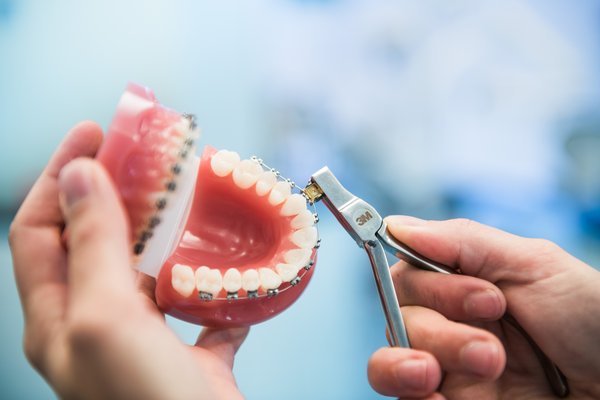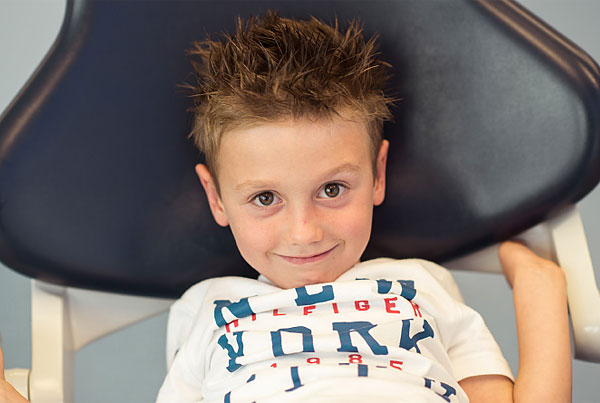for children and young adults
General knowledge
Roughly 85% of children and young adults have a less or well-developed teeth and jawbone malposition. Based on this knowledge, it is not surprising that the biggest client group in orthodontist’s practices is nine to 14-year-olds. The advantage is obvious: teeth and jawbone malpositions have not consolidated yet at this age and their treatment is therefore very successful.
Early treatment
MUNDWERK Die Kieferorthopäden is specialized in the treatment of children and young adults.
Teeth can be shifted throughout one's life. The jawbone, however, can be formed only in the early years of development. Because of that, children between the ages seven and eight, latest before they turn 11, should visit an orthodontist.
The right timing for treatment
Many parents are concerned about missing the right time to start an orthodontic treatment for their children. There is no one rule, every child is different and so are their teeth and jawbones. To make sure not to miss the right moment, we advise you to come in for a consultation. Our team of specialists knows these difficulties about dental malpositions and can give you a detailed diagnosis.
Small children should visit an orthodontist once their incisors change, if there has not been a diagnosis by a pediatrician or dentists about a severe malposition. Subsequently, once the first permanent tooth is coming out, it's time for the orthodontist.
In the first phase of permanent teeth, which usually is the case for children between five and six years of age, the orthodontist can identify if dental and jawbone malpositions could hinder the dental growth. In this case, the children would receive braces in an early treatment plan. These braces would be mainly very simplified loose or firm braces. Most of the time, these braces are being well-perceived by our little clients and are only worn during the night or a few hours of the day. Early treatment plans are only relevant for about 3-5% of the children, they take between one and one and a half years and will nearly always be covered by health insurance.
A consultation will clarify
In the second phase of permanent teeth, between nine and ten years of age, it is very important to have the dental position checked by an orthodontist: in the main stage of dental growth malpositions can be treated very successfully! Dentists can give a general overview about malpositions, but for a detailed diagnosis and consultation it is necessary to visit an orthodontist’s practice.
During a consultation we are looking closely at the teeth, their positioning, the upper and lower jawbone, as well as the form of the bite. Afterwards, we are evaluating if and to what extent an orthodontic treatment is necessary. We are producing extensive diagnostic documentations and are checking thoroughly what type of treatment is the right one for the child.
We will then discuss everything in detail with you, especially regarding the treatment plan, such as: which type of braces is necessary, how long will the treatment last, and what certain services will cost. Following this, we will set up a treatment plan, which we will send to the insurance company. Patients who are insured privately or have supplemental dental insurance will receive their treatment and financial plan in the mail and can send it directly to their insurance company. As soon as the confirmation has been received we can start the orthodontic treatment immediately!
My child has a cleft lip and palate. How an orthodontist can help you.
What is a bad habit and what it can cause.
The course of the treatment
The treatment is often divided into three phases:
In the first phase, the dental arcade is being reshaped over the course of six to eight months by usually loose braces.
Afterwards the bite form will be adjusted with the help of loose braces as well. The time frame for this procedure can vary by a lot. Of course, the motivation and dedication of the child plays a big role in this phase.
In the third phase, the teeth will be adjusted properly by permanent braces (multi banded-multibracket apparatus) so the final fit after the active orthodontic treatment will be optimal.
Nowadays, the adjustment of the teeth is more and more being achieved through the use of transparent retainers, called Aligners. Details or questions can be discussed between patients, parents, and the orthodontist.
This includes the wide spectrum of probable costs of an orthodontic treatment. In most cases, the costs of the correction of the dental and jawbone malposition of patients is being covered by the insurance companies. Additional services, like an orthodontic prophylaxis, protective coating for the brackets, materials for esthetic treatments, and examinations of the mandibular joint are to be discussed individually. Since, every patient has their own ideas and wishes. In these cases, a supplemental dental insurance is sensible, regarding the coverage of additional costs, and should be decided upon before the consultation appointment with the orthodontist.
Oral hygiene for small children, children, and young adults
Every new tooth needs to be carefully cleaned from the beginning on, because bacteria is not differentiating between milk teeth and permanent teeth. The brushing of new teeth coming through is not easy, especially when the gums are exposed. However, it is very important that parents are brushing these teeth carefully and thoroughly and they don’t have to worry about hurting the new teeth.
Make sure to use an age adequate toothbrush that has a smaller head. The minimum amount of three minutes for brushing should be used in the best way possible - a teeth brushing timer could be useful. Further, the fluoride in the toothpaste will need that time to activate and protect the dental surface. Finally, the toothpaste should have a good taste.
Dental floss is indispensable for the cleaning of the interdental space, since those spaces are not reachable with a toothbrush. Ideally, dental floss should be used daily.
Generally, children enjoy brushing their teeth if it is done with an electric toothbrush. This circumstance can be used to start early on using an electric toothbrush for children. These toothbrushes, which are appropriate for children, have the right sized head, a suitable handle, and often an incorporated timer which can play different melodies while brushing the teeth. Once the child is ready to rinse, it is advised to gargle with a fluoride rinse solution to support the enamel.
The sooner children start to brush their own teeth, the better it is! The role model function of the parents is, like in so many other cases in life, of utmost importance. If possible, parents should sit across from their children and brush their teeth together. Because, children won’t invest more time into brushing their teeth, then their parents do. Therefore, it is always important for parents to control and influence the quality of their children's oral hygiene.
Children during kindergarten and elementary school are advised to brush their teeth following a simple method. First, brushing for one minute the occlusal surface of the teeth with the mouth open. Second, brushing the front side surface of the teeth pressing upper and lower teeth together. Third, brushing the inside surface of the teeth with the mouth open.
Some children are capable of responsibly taking over their own oral hygiene at the age of eight, others might do so at the age of nine or ten. This depends on the individual development of the motor skills. Since, in order to properly brush your teeth sophisticated movements are required.
We recommend a prophylaxis twice a year, in case of permanent braces at least three times a year. The professional teeth cleaning is not covered by health insurance, however some insurance companies offer individual prophylaxis programs. Different prophylaxis packages, like clarification, motivation and fluoridation, can be made accessible for a certain time through the insurance company. General prophylaxis is conducted by a dentist. In this procedure all dental surfaces are being cleaned and polished. In an orthodontic prophylaxis all dental surfaces are being cleaned and polished on which permanent braces are attached to. While cleaning the teeth we are being very cautious and careful. As a matter of fact: better get your prophylaxis done once too many, then once too few.






![[Translate to Englisch:] Gesellschaft für Kieferorthopädie von Berlin und Brandenburg e. V.](/fileadmin/_processed_/c/0/csm_kfobb-Logo_1703de3472.jpg)
![[Translate to Englisch:] Berufsverband der Deutschen Kieferorthopäden e.V.](/fileadmin/_processed_/5/0/csm_BDK-Logo_d39394fbff.jpg)
![[Translate to Englisch:] Deutsche Gesellschaft für Kieferorthopädie e.V.](/fileadmin/_processed_/2/c/csm_DGKFO-Logo_0302f6bac0.jpg)
![[Translate to Englisch:] Deutsche Gesellschaft für Linguale Orthodontie](/fileadmin/_processed_/0/9/csm_DGLO-Logo_47fadfe3a1.jpg)

![[Translate to Englisch:] Deutsche Gesellschaft für Aligner Orthodontie](/fileadmin/_processed_/1/5/csm_dgao-Logo_88c958f5a8.jpg)
![[Translate to Englisch:] The Angle Orthodontist](/fileadmin/_processed_/5/2/csm_TheAngleOrthodontist-Logo_ff8b6ec686.jpg)
![[Translate to Englisch:] European Masters of Aligners](/fileadmin/_processed_/7/c/csm_EUMAA-Logo_db68347fe8.jpg)